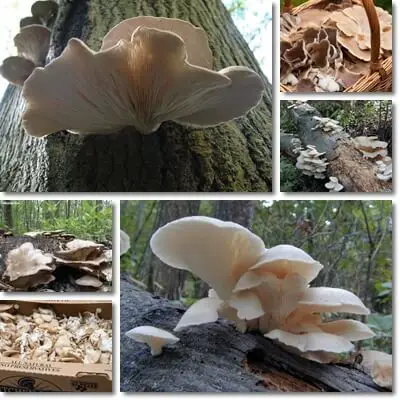Commonly known as the oyster mushroom, the grey oyster mushroom, pearl or tree oyster mushroom, Pleurotus ostreatus is a popular species of edible mushroom growing on trees. It belong to the genus Pleurotus and is related to the king oyster mushroom. The species is one of the most popular edible varieties and a source of excellent nutrition and varied health benefits. Pleurotus ostreatus is a good source of protein and dietary fiber, potassium and phosphorus, vitamins B6, B9 and an excellent source of vitamins B2 and B3.
What do oyster mushrooms look like? None of the species in the Pleurotus genus look like your typical mushroom. For one, the Pleurotus ostreatus species grows on tree trunks or fallen logs, hence why it’s commonly known as the tree oyster mushroom. Its more common name, ‘oyster mushroom’, and the slightly less generic ‘pearl oyster mushroom’ are owed to the fact that the shape of the cap resembles the shape of oyster shells, shellfish known to produce pearls. Specimens occur in overlapping clusters, in a shelf-like arrangement. Color ranges from white to light grey to yellowish-brown to brown. The flesh is white and tender.

Oyster mushrooms typically have an irregular-shaped cap with a fan-like outline. The cap has smooth margins which can be rounded, lobed or wavy, depending on the age and size of the mushroom. The cap is convex, with margins pointing slightly downwards, but tends to flatten as the mushroom matures. In mature specimens, there is a sunken area in the cap, a depression located right above the stipe or the stalk. The cap is smooth on top and presents narrow, elongated gills on the underside extending downwards on the stalk, if present. Existing stalks are typically stubby, short and thick, and are disposed laterally.
What do (tree/pearl) oyster mushrooms taste like? Oyster mushrooms of the Pleurotus ostreatus species are mild, but pleasant-tasting with faint earthy tones. The taste can be described as savory (umami) and is slightly more pregnant than that of white champignons or portobellos. The cap is tender and moist, with a meaty texture when cooked. A lot of people like to discard the stalk of older specimens as they feel it’s not as tender as the cap. When using this variety for cooking, make sure to wash well and remove any dust, dirt, straw or insects that may be on the cap or in the gills. Gently pat dry with a paper towel, then proceed to cook. Also see benefits of portobello mushroom.
If you sourced from the wild, it’s important not to confuse tree or pearl oyster mushrooms with inedible look-alikes such as the ghost fungus (Omphalotus nidiformis) or the western jack-o’-lantern (Omphalotus olivascens) which are both toxic. Or with other similar-looking, but inedible species. Even if you find them on a tree trunk or log, where oyster mushrooms usually grow, if you are not 100% sure you can identify the species correctly, it’s best to just leave them there.

Nutrition facts per 100 g
Energetic value: 33 kilocalories (kcal) per 100 g
Carbohydrates: 6 g, of which 1.1 g are sugars
Dietary fiber: 2.3 g
Protein: 3.3 g
Fat: 0.4 g
Water content: over 89 g
Vitamin B2: 0.349 mg out of a recommended daily intake (RDI) of 1.3 mg for men and 1.1 mg for women
Vitamin B3: 4.956 mg out of a RDI of 16 mg for men and 14 mg for women
Vitamin B6: 0.110 mg out of a RDI for 1.3 mg
Phosphorus: 120 mg out of a RDI of 700 mg
Potassium: 420 mg out of a RDI of 4700 mg
The Pleurotus ostreatus species, identified by its common name as the tree or pearl oyster mushroom, boasts good nutritional value and is an important source of protein and dietary fiber for muscles and digestive health, potassium for hypertension and phosphorus for strong bones and teeth. It provides good amounts of vitamin B9 (folate) for pregnant women and excellent amounts of vitamin B3 for skin and nervous system health. Other less notable nutritional facts: modest magnesium, vitamin B2 and B6 content and trace amounts of vitamins A, B1, B5 and vitamin D, calcium, copper, iron, manganese, selenium, sodium and zinc. Nutrition facts may differ between wild-sourced and commercially cultivated oyster mushrooms of the Pleurotus ostreatus species.
See also: Can You Eat Raw Mushrooms?
Health benefits
Eating Pleurotus ostreatus or oyster mushrooms has several wonderful benefits for health. For one, the species is a good source of carbohydrates and several B vitamins (B2, B3, B9) and thus benefits our energy metabolism. Low in calories and fat (only 33 kcal/100 g and around 0.4% fat), it supports healthy weight loss. With 2.3 g of dietary fiber per 100 g, oyster mushrooms help regulate transit time and bowel movements, contributing to constipation relief.
Oyster and other mushrooms are good sources of vitamin B2, providing around 25% of the recommended daily intake, RDI, for an average adult male and and a little over 30% of the RDI for an adult woman. Vitamin B2 holds benefits for skin and nervous system health. Furthermore, because it affects iron metabolism, not meeting daily requirements represents a risk factor for anemia so including vitamin B2-rich foods such as meat, milk, dairy, eggs, mushrooms, nuts, seeds or whole grains into your diet is important for good health.
A serving of 100 g of oyster mushrooms provides 4.956 mg of vitamin B3 which is a little over 30% of the recommended daily intake, RDI, for adult men and a little under 305 of the RDI for adult women. Applied topically, the nicotinamide form of vitamin B3 reduces sebum production which can potentially hold benefits for acne. Niacin, another form of vitamin B3, has been found to hold benefits for skin, hair, cardiovascular, digestive and nervous systems.
Getting enough of vitamin B3 from food sources such as oyster mushrooms helps raise HDL (good) cholesterol levels and lower LDL (bad) cholesterol. While raising HDL levels alone produces benefits for cardiovascular health in general, lower LDL levels is even more beneficial. Lastly, sufficient amounts of vitamin B3 contributes to better blood pressure numbers.
Vitamins B2 and B9 in oyster mushrooms hold benefits for pregnant women, helping prevent birth defects and contributing to improved energy levels and anti-anemia effects during pregnancy. Good amounts of phosphorus (under 20% of the RDI) promote strong, healthy bones and teeth.
Pleurotus ostreatus for hypertension. With a little under 9% of the recommended daily intake of potassium, oyster mushrooms in the Pleurotus ostreatus species benefits cardiovascular health significantly. Potassium is an electrolyte that helps balance sodium levels in the blood, counteracting water retention and lowering high blood pressure numbers.
Pleurotus ostreatus for cholesterol. Pearl or tree oyster mushrooms and other species of the genus promote healthier cholesterol levels as a result of being low in fat, calories, but a good source of both dietary fiber and B vitamins, especially vitamins B2 and B3. But oyster mushrooms are also a natural source of lovastatin. The naturally-occurring compound lovastatin lowers the liver’s production of cholesterol in an effort to reduce LDL cholesterol (low-density lipoprotein) and triglyceride levels in the blood, contributing to a reduced risk of atherosclerosis and cardiovascular events. Lovastatin also occurs naturally in red yeast rice, a fermented red rice variety. See benefits of red rice.
Side effects and contraindications
No food is universally healthy and without side effects and this is true for oyster mushrooms too.
1) Can cause allergic reactions. Both Pleurotus ostreatus and other Pleurotus species can be a source of allergic reactions in a small part of the population. If allergic, it is important to avoid the mushrooms in all forms and preparations.
2) Gastrointestinal side effects. Whether it’s because of the fiber, the naturally-occurring lovastatin, an excess intake or an innate sensitivity or intolerance or all of these factors combined, oyster mushrooms can be a source of digestive discomfort and cause side effects such as loose stools and diarrhea, stomach upset, cramps, flatulence, indigestion etc.
3) Potential source of heavy metals. Studies show specimens of wild oyster mushrooms accumulate heavy metals such as cadmium and mercury from the surrounding environment. The more contaminated the environment they grow in and the older and larger the specimens, the higher the uptake.
4) Liver problems. Because the liver is in charge of detoxifying the body, it’s advised to limit intake of Pleurotus mushrooms if you have liver problems. An excess intake is contraindicated because it could mean an excess intake of lovastatin or heavy metals which could potentially be a source of side effects.
